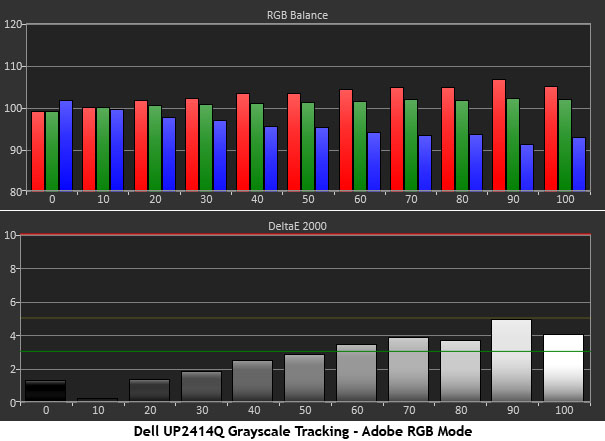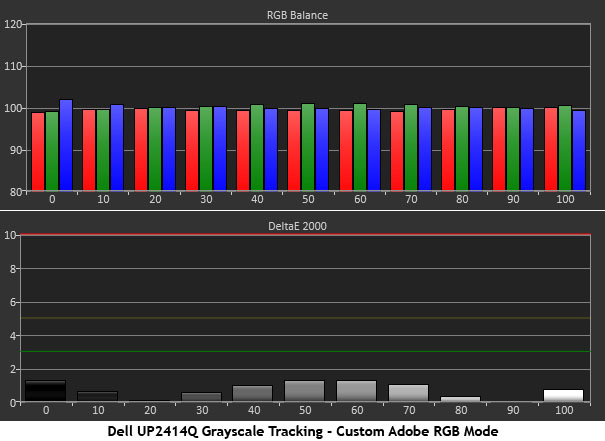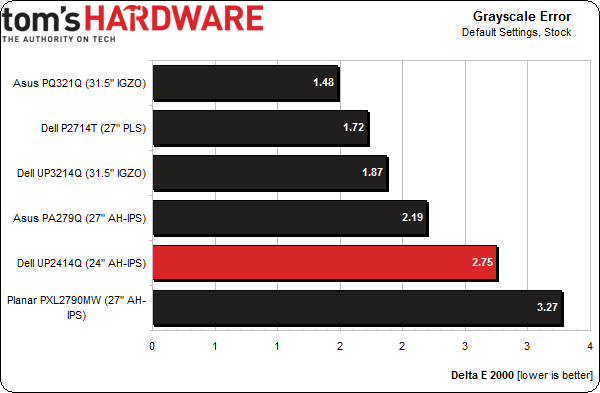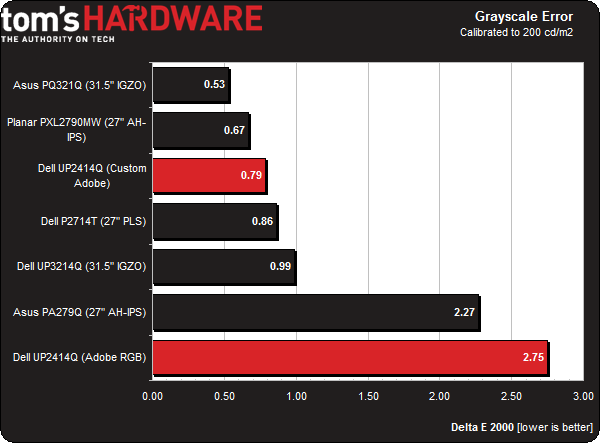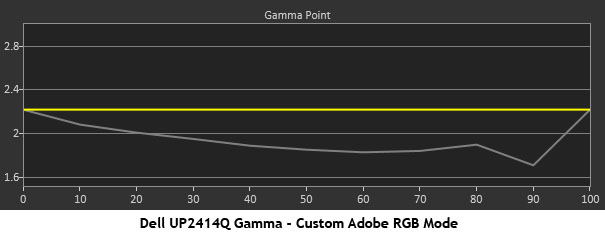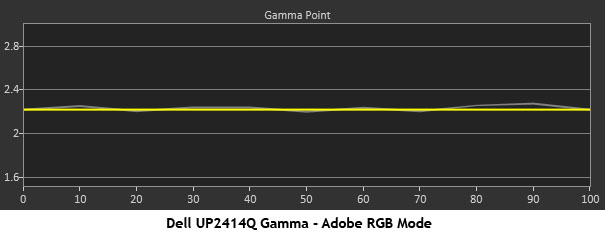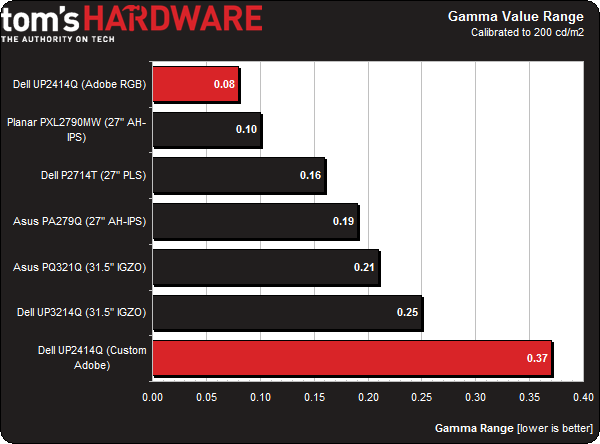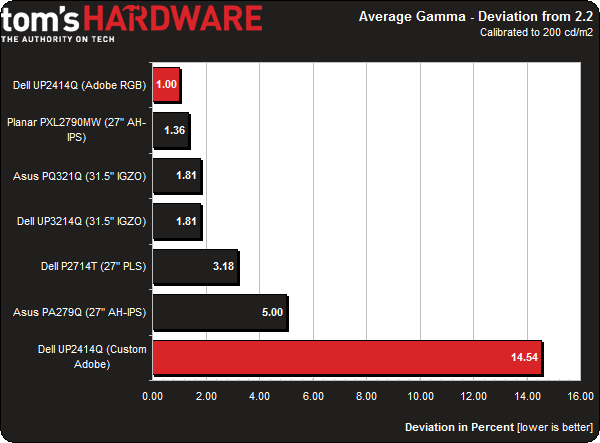Dell UltraSharp 24 Ultra HD Monitor: The $1300 UP2414Q
Dell now offers three Ultra HD monitors for your consideration. We tested the 32-inch UP3214Q last month. Today, we’re looking at the 24-inch UP2414Q. Despite its smaller size, this is still a $1000+ display. Can Dell make the trade-off worthwhile?
Results: Grayscale Tracking And Gamma Response
The majority of monitors (especially newer models) display excellent grayscale tracking, even at stock settings. It’s important that the color of white be consistently neutral at all light levels from darkest to brightest. Grayscale performance impacts color accuracy with regard to the secondary colors: cyan, magenta, and yellow. Since computer monitors typically have no color or tint adjustment, accurate grayscale is key.
At this point, we thought the UP2414Q would respond similarly to the UP3214Q, since it has identical color modes and calibration controls. After considerable experimentation, though, we discovered the two monitors are actually quite different.
For instance, Dell's UP3214Q has an excellent Custom Color mode, which gives you two-point grayscale controls and a color management system facilitating top-notch results. The UP2414Q offers the same controls. However, we recorded inferior numbers in the Custom mode and wound up settling on the fixed Adobe RGB mode as the most accurate configuration.
We’ll let the measurements tell the story.
This is the chart you can expect in both the Adobe RGB and sRGB color modes. You're only able to adjust Brightness and Contrast; grayscale and color gamut cannot be dialed-in. The result isn’t bad per se, but we really do miss white balance controls.
We tried out the available sliders in Dell's Custom Color mode:
This is an excellent measurement run that comes within a whisker of the UP3214Q’s Custom mode chart. Unfortunately, if you want that level of grayscale performance from the UP2414Q, you’ll have to accept some compromises in gamma and color gamut accuracy. Keep reading to see those results.
Get Tom's Hardware's best news and in-depth reviews, straight to your inbox.
Here’s our comparison group again:
Our instruments return an error of 2.75 Delta E in Adobe RGB mode, which is a little higher than Dell’s claim of two Delta E, though perhaps this can be attributed to our specific press sample. Other UP2414Qs might measure higher or lower. And really, the error is still invisible. Some monitors do perform better at their default settings. But when the error is under three, you won’t be able to distinguish it with anything but a colorimeter.
What follows are the fixed and Custom Adobe RGB mode results.
Having white balance controls available helps get us an extremely low error of .79 Delta E. That's right up there with the best screens we’ve tested. In the fixed Adobe RGB mode, all we could do was adjust Brightness to our 200 cd/m2 standard level and tweak the contrast so the error remained the same.
Gamma Response
Gamma is the measurement of luminance levels at every step in the brightness range from 0 to 100 percent. This is important because poor gamma can either crush detail at various points or wash it out, making the entire picture appear flat and dull. Correct gamma produces a more three-dimensional image, with a greater sense of depth and realism. Meanwhile, incorrect gamma can negatively affect image quality, even in monitors with high contrast ratios.
In the gamma charts below, the yellow line represents 2.2, which is the most widely accepted standard for television, film, and computer graphics production. The closer the white measurement trace comes to 2.2, the better.
You saw above how great the grayscale tracking was in the Custom mode. This gamma chart is the tradeoff.
The UP2414Q seems to use its Standard mode as the basis for adjustment in the Custom modes. A poor gamma trace is one of the byproducts of that mode. Yes, you can have super-accurate white balance. The trade-off is gamma that is too light in tone throughout its range. After seeing this and the gamut results, I decided the non-adjustable modes are superior.
And here’s the chart in Adobe RGB mode.
Much better, right? That's a trace more befitting a professional-caliber display. It is disappointing to see such a difference compared to the UP3214Q. In all fairness though, the fixed modes, while not perfect, do offer decent performance.
Here’s our test group once more for the gamma comparisons.
The gamma in Adobe RGB mode is pretty much perfect, and that's the kind of accuracy we'd expect from a pro-level tool.
Our test was run in PC mode, which adheres to the 2.2 standard. If you use a Mac, there is preset that changes the gamma to 2.0. The measured tracking is equally flat.
We calculate gamma deviation by simply expressing the difference from 2.2 as a percentage.
With only a one percent deviation from 2.2, this result is within a hair of perfection as well. The biggest luminance error is at 90 percent, where it’s off by only 1.1 cd/m2.
Current page: Results: Grayscale Tracking And Gamma Response
Prev Page Results: Brightness And Contrast Next Page Results: Color Gamut And Performance
Christian Eberle is a Contributing Editor for Tom's Hardware US. He's a veteran reviewer of A/V equipment, specializing in monitors. Christian began his obsession with tech when he built his first PC in 1991, a 286 running DOS 3.0 at a blazing 12MHz. In 2006, he undertook training from the Imaging Science Foundation in video calibration and testing and thus started a passion for precise imaging that persists to this day. He is also a professional musician with a degree from the New England Conservatory as a classical bassoonist which he used to good effect as a performer with the West Point Army Band from 1987 to 2013. He enjoys watching movies and listening to high-end audio in his custom-built home theater and can be seen riding trails near his home on a race-ready ICE VTX recumbent trike. Christian enjoys the endless summer in Florida where he lives with his wife and Chihuahua and plays with orchestras around the state.
-
dweezled This is a joke right? Dell making yet another mockery of the monitor market.Reply
Why oh why when you can get the latest 10-bit AH-IPS technology in the 2560 x 1600 30" Crossover Black Tune 30x for $700?
-
s3anister Reply13121759 said:This is a joke right? Dell making yet another mockery of the monitor market.
Why oh why when you can get the latest 10-bit AH-IPS technology in the 2560 x 1600 30" Crossover Black Tune 30x for $700?
You obviously miss the point of this monitor. The whole point of a 24" 4K monitor is the pixel density. The fact that it's 8-bit and not 10-bit probably isn't going to bother a whole ton of people and if 4K and 10-bit is what you need than you'd be looking at the Dell Ultrasharp UP3214Q anyway. http://www.tomshardware.com/reviews/ultrasharp-32-up3214q-review,3744-7.html -
Treynolds416 I love the super indepth articles you guys do, but it would be nice if you also did more reviews about less expensive things, like cases. I mean, it's interesting to read about a $1k monitor but it would be more helpful to more people if you did a case roundup or a higher volume of reviews about them. You don't have to stop making monitor reviews or anything because it's certainly not hurting anyone, but it seems like there are more articles about expensive monitors that most people can't buy/don't have a use for in lieu of articles about more fundamental pieces of computer hardware.Reply
Just my two cents -
gadgety $1300 for a simple panel is a joke, specially when "From our experience so far, these 4K monitors work well, but still have some maturing to do." Thank you for the straightforward, no nonsense review. I'll wait.Reply -
dstarr3 Ahh, 24" 4k monitors are a reality now. Antialiasing in games is soon to be a thing of the past. Which is relieving, because that makes the task on graphics cards a lot more manageable.Reply -
xenol (quote thing isn't working for me)Reply
"Ahh, 24" 4k monitors are a reality now. Antialiasing in games is soon to be a thing of the past. Which is relieving, because that makes the task on graphics cards a lot more manageable. "
It actually makes it worse if not does nothing. 4K is the equivalent, almost, of 1080p using SSAAx4. MSAA is a lot cheaper and most games are resorting to FXAA or MLAA because it's incredibly cheap, works with any rendering method (Deferred rendering doesn't play nice with MSAA), and the quality is almost as good. -
dstarr3 Reply4K is the equivalent, almost, of 1080p using SSAAx4.
And modern graphics cards can handle that kind of workload. So, since they're basically equivalent, it isn't a lot more to ask of cards to do 4k without any AA. -
soldier44 LOL 24" yeh right for that price, make it 30 inches at 4K for that price and i'll bite.Reply
